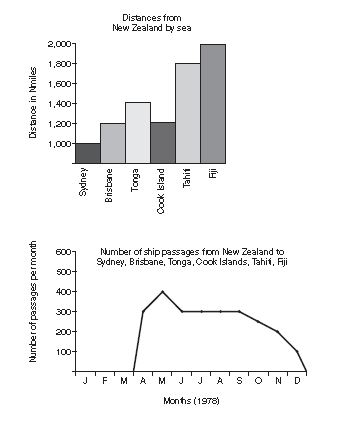Data set 5: Distances from New Zealand by sea
Posted by Superadmin on March 08 2016 15:30:09

Notes:
An Nmile is a nautical mile and is 10% greater than a mile (used to measure distance on land).
Tropical storms January–March.
Ships only make these passages before or after the tropical storm season.
The month of May offers the best weather conditions.
The southern ocean current runs at 2 knots/hour west to east all year.
Ships on passage to Sydney and Brisbane must push against the southern ocean current.
Ships on passage to Tonga, Cook Islands and Tahiti are carried along by the southern ocean current.
Ships on passage to Fiji cross the current and so experience no counter or favourable effect.
1. The distance by sea from New Zealand to Brisbane and back is:
A 2,400 Nmiles
B > 2,400 Nmiles
C < 2,400 Nmile
D Cannot tell
Answer( )
2. How many ship passages from New Zealand to Sydney, Brisbane, Tonga, Cook Island, Tahiti and Fiji took place in
1978?
A 2,550
B 2,250
C 2,450
D 2,400
E Cannot tell
Answer( )
3. In land miles, what is the distance from New Zealand to Tonga?
A 1,400 miles
B 1,440 miles
C 1,500 miles
D 1,540 miles
E Cannot tell
Answer( )
4. If in the month of December half of all the passages that month were to Sydney and the remainder were to Fiji, how many Nmiles would be covered in total?
A 100,000 Nmiles
B 150,000 Nmiles
C 200,000 Nmiles
D 250,000 Nmiles
E Cannot tell
Answer( )
5. How far is it from Sydney to Fiji?
A 3,000 Nmiles
B 2.000 Nmiles
C 800 Nmiles
D Cannot tell
Answer( )
6. Over a 30-day period during the 1978 storm season, 5 days were classed as experiencing storm conditions. What is the ratio of stormy and non-stormy days during this period?
A 1:3
B 1:4
C 1:5
D 1:6
Answer( )
7. What proportion of the total passages for the year 1978 was made in the months June, July, August and September?
A < Half
B > Half
C Exactly half
D Cannot tell
Answer( )
8. Taking account of the distances and the currents, if a ship were to sail to New Zealand to Brisbane return and then New Zealand to Cook Island return at a constant speed, which passage would you expect to be completed the quicker?
A New Zealand–Brisbane return
B Both passages would take the same amount of time
C New Zealand–Cook Island return
D Cannot tell
9. If 12% of all passages made in 1978 were to Cook Island, how many sailings were there to this destination that year?
A 306
B 302
C 298
D 294
Answer( )
10. A ship on passage from New Zealand to Sydney averages 10 Nmiles/hour through the water and 8 Nmiles/hour over the ground. How many hours would the journey take?
A 125 hours
B 120 hours
C 110 hours
D 100 hours
Answer( )
Data set 5
1. Answer A, 2,400 Nmiles
Explanation: The distance from New Zealand to Brisbane (1,200 Nmiles) can be read from the bar chart and the distance there and back is therefore 2,400 Nmiles.
2. Answer C, 2,450
Explanation: Simply total the number of passages for each month from April (300) to December (100).
3. Answer D, 1,540 miles
Explanation: In the notes we are told that an Nmile is 10% greater than a land mile so the distance from New Zealand to Tonga measured in land miles in 110% of the distance in Nmiles.
1,400 × 110% = 1,540 miles.
4. Answer B, 150,000 Nmiles
Explanation: In December there are 100 passages and 50 travel 1,000 Nmiles to Sydney, the other 50 travel 2,000 Nmiles to Fiji; this gives (50 × 1, 000 = 50,000) + (50 × 2,000 = 100,000) =
150,000 Nmiles in total.
5. Answer D, Cannot tell
Explanation: We are not given enough information regarding their relative positions and so there is insufficient information to calculate the distance between Sydney to Fiji.
6. Answer C, 1 : 5
Explanation: There are 5 stormy days and 25 non-stormy days during the period. This gives the ratio 5 : 25, which expressed in its simplest form is 1 : 5.
7. Answer A, , Half
Explanation: From a previous question the total number of passages was calculated to be 2,450. The total for the months June–September is 1,200 which is slightly less than half the total for the year.
8. Answer B, Both passages would take the same amount of time
Explanation: The passages are the same distance and both would experience adverse currents one way and favourable currents the other, so the effect of the currents is cancelled out. Therefore you would expect the passages to take the same amount of time.
9. Answer D, 294
Explanation: There were a total of 2,450 sailings. To find 12% of this total, divide by 100 to get 1% and then multiple by 12 (2450 ÷ 100 = 14.5 × 12 = 294).
10. Answer A, 125 hours
Explanation: The distance is 1,000 Nmiles and the speed that counts is the speed over the ground (the speed through the water will be higher because of the counter current)
The answer is therefore 1,000 ÷ 8 = 125.
